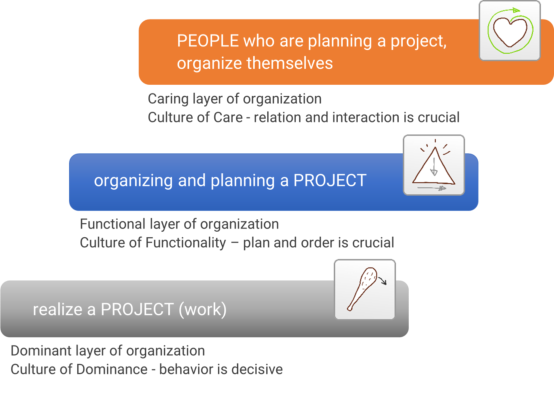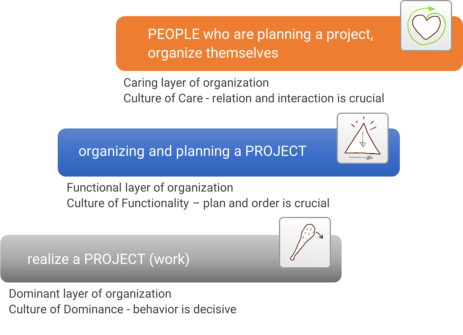Successful
cooperation
is
both
a
path
and
a
goal.
Good
methods
and
tools
make
it
much
easier
for
a
team
to
organize
itself.
Encourage
your
team
to
take
the
first
steps
in
this
direction
and
experience
the difference.



6 Hurdles to Self-Organization

How to turn your team
into the boss
Hurdle 1: Establishing the appropriate team culture
Home / hurdle 1: team culture /
Chapter 02 – The Cultural Stages



- The 6 Hurdles
- The Elements
- What are the Elements
- Culture Stage Model
- Gut, Head or Herart Process
- Culture Change
- List of Feelings and Needs
- Emergency Emo-Step
- Four Step Circle
- NVC Magic Circle
- Utopia Magic Circle
- Utopia and Vision
- No-Goes and Must-Haves
- Pain Points
- Consensus
- Requirement Lists
- NVC-plus Strategy
- NVC-plus Matrix
- Discourse
- Card Set
- Download-Tool-Depot
- FAQs
- Events
- Media



What
is
this
about?
It
is
about
a
new
level
of
how
people
organize
themselves
for
the
organization of a project.
We can identify three layers for the organization of a project:
On
the
one
hand,
there
is
the
functional
organization
of
the
project
(layer
2)
and,
on
the
other
hand,
the
completely
different
character
of
the
organization
of
people
to
each
other
(layer
3),
who jointly organize (layer 2) and implement (layer 1) a project.
The
purely
functional
project
organization
has
been
brought
under
control
over
time.
The
keywords
here
are
quality
management,
standardization
and
automation.
With
the
new
possibilities
offered
by
technology,
programming,
apps
and
today's
communication
options,
this
is
all
well
on
the
way.
With
lean,
agility
and
value
stream
management,
there
is
a
lot
of
knowledge
in
the
area
of
functional
project
management.
Only
one
question
remains
unsatisfactorily
resolved:
Who
organizes
the
people
planning
and
executing,
and
how?
The
standard
functional
answer
at
layer
2
is:
Well,
people
are
planned
like
machines
and
cogwheels,
by
people
who
are
organized
like
machines
and
cogwheels.
And
the
big
boss
organizes
them
like
machines
and
cogwheels,
i.e.
always
in
a
causally
predictable
way.
Unfortunately,
people
are
miscalculating
more
and
more,
because
life
cannot
be
calculated,
it
can
only
be
lived.
In
the
dominant
and
functional
peak
times,
it
worked
even
better
than
it
does
now,
as
more
and
more
people
are
waiting
to
make
the
leap
into
the
caring
world
together.
They
no
longer
want
to
be
planned like machines and cogwheels.
At
NVC-plus,
the
answer
is
therefore:
The
Team
is
the
Boss.
The
team
organizes
the
process
and
must be able to organize itself. This requires a new cultural approach to organizing.
After
the
art
of
functional
organizing
(layer
2),
it
is
now
about
the
higher
art
of
human
organizing
in
relation
to
functional
projects.
Layer
3
is
added
and
the
organization
of
people
is
no
longer
the
task of functional layer 2. The team members are no longer scheduled, they plan together.
Why are we suggesting that the team should be the boss?
•
Because
each
person
in
their
position
and
from
their
perspective
has
a
proportionate
knowledge of the whole that is valuable.
•
Because
each
person
in
their
position
can
intervene
quickly
and
concretely
and
balance
the
project.
•
Because
each
person
can
add
meaning,
awareness,
inspiration
and
significance
to
the
project.
•
Because
individual
meaning
and
significance
can
only
be
well
networked
through
shared
caring.
•
Because
we
urgently
need
this
more
networked,
actively
lived
sense
and
meaning
to
overcome crises and steer progress.
•
Because the core pleasure of activity is the experience of shared constructiveness.
•
because
this
is
often
the
only
way
to
manage
complex
tasks
appropriately
and
our
world
is
becoming increasingly complex anyway.
•
Because the systemic, phenomenal influences can also have a positive effect on the project.
•
Because
people
no
longer
want
to
be
cogwheels
in
the
big
socio-economic
machine
and
are
increasingly refusing to be conscious in the form of illness, depression and burnout.
The
earth
makes
the
garden.
That
is
why
the
environment
in
which
the
team
is
located
is
not
insignificant.
The
culture
of
cooperation
determines
the
interpersonal
climate,
the
quality
of
communication,
the
commitment
of
the
members
and
their
success
in
self-organization.
Therefore,
selecting
the
team
culture
is
the
first
step
for
a
self-organized
team.
However,
in
order
to
be
able
to
select
a
culture,
you
first
need
an
overview
of
all
the
different
cultures
that
would
be suitable.
Self-organization requires a suitable team culture
Self-organization
that
makes
the
team
the
boss
requires
trust,
transparency
and
communication.
However,
all
three
factors
are
heavily
dependent
on
the
culture
of
the
team.
We
therefore
first
need
a
suitable
team
culture
that
promotes
these
three
qualities,
and
we
can
understand
what
this
might
be
using
the
NVC-plus
culture
stage
model.
But
even
if
we
strive
for
a
certain
team
culture,
there
is
still
the
question
of
how
we
can
practically
introduce
it
into
the
company
and
what that would mean for each team member. Here are the three points that are important
Take
a
look
at
these
three
points
and
discuss
them
with
your
team.
If
you
are
interested
in
this
topic,
sign
up
for
the
newsletter
and
find
out
more
about
NVC-plus
and
the
organic
self-
organization of teams and companies.

1. NVC-plus culture stage model

2. Gut - head - heart - the three control centers of the human body

3. How to bring about a cultural change in the team
Every team, start-up, or company must overcome these six hurdles if it wants to organize itself
collegially in order to successfully manage projects from within the community.





Quick Start

Chapter 02 – The Cultural Stages


- The 6 Hurdles
- The Elements
- What are the Elements
- Culture Stage Model
- Gut, Head or Herart Process
- Culture Change
- List of Feelings and Needs
- Requirement Lists
- NVC Magic Circle
- Utopia Magic Circle
- Emergency Emo-Step
- Four Step Circle
- Utopia and Vision
- No-Goes and Must-Haves
- Pain Points
- Consensus
- NVC-plus Strategy
- NVC-plus Matrix
- Discourse
- Card Set
- Download-Tool-Depot
- FAQs
- Events
- Media


Successful
cooperation
is
both
a
path
and
a
goal.
Good
methods
and
tools
make
it
much
easier
for
a
team
to
organize
itself.
Encourage
your
team
to
take
the
first
steps
in
this
direction
and
experience
the
difference.
What
is
this
about?
It
is
about
a
new
level
of
how
people
organize
themselves
for
the
organization
of a project.
We
can
identify
three
layers
for
the
organization
of a project:
On
the
one
hand,
there
is
the
functional
organization
of
the
project
(layer
2)
and,
on
the
other
hand,
the
completely
different
character
of
the
organization
of
people
to
each
other
(layer
3),
who
jointly
organize
(layer
2)
and
implement
(layer 1) a project.
The
purely
functional
project
organization
has
been
brought
under
control
over
time.
The
keywords
here
are
quality
management,
standardization
and
automation.
With
the
new
possibilities
offered
by
technology,
programming,
apps
and
today's
communication
options,
this
is
all
well
on
the
way.
With
lean,
agility
and
value
stream
management,
there
is
a
lot
of
knowledge
in
the
area
of
functional
project
management.
Only
one
question
remains
unsatisfactorily
resolved:
Who
organizes
the
people
planning
and
executing,
and
how?
The
standard
functional
answer
at
layer
2
is:
Well,
people
are
planned
like
machines
and
cogwheels,
by
people
who
are
organized
like
machines
and
cogwheels.
And
the
big
boss
organizes
them
like
machines
and
cogwheels,
i.e.
always
in
a
causally
predictable
way.
Unfortunately,
people
are
miscalculating
more
and
more,
because
life
cannot
be
calculated,
it
can
only
be
lived.
In
the
dominant
and
functional
peak
times,
it
worked
even
better
than
it
does
now,
as
more
and
more
people
are
waiting
to
make
the
leap
into
the
caring
world
together.
They
no
longer
want
to
be
planned
like
machines and cogwheels.
At
NVC-plus,
the
answer
is
therefore:
The
Team
is
the
Boss.
The
team
organizes
the
process
and
must
be
able
to
organize
itself.
This
requires
a
new cultural approach to organizing.
After
the
art
of
functional
organizing
(layer
2),
it
is
now
about
the
higher
art
of
human
organizing
in
relation
to
functional
projects.
Layer
3
is
added
and
the
organization
of
people
is
no
longer
the
task
of
functional
layer
2.
The
team
members
are
no longer scheduled, they plan together.
Why
are
we
suggesting
that
the
team
should
be
the boss?
•
Because
each
person
in
their
position
and
from
their
perspective
has
a
proportionate
knowledge of the whole that is valuable.
•
Because
each
person
in
their
position
can
intervene
quickly
and
concretely
and
balance
the project.
•
Because
each
person
can
add
meaning,
awareness,
inspiration
and
significance
to
the
project.
•
Because
individual
meaning
and
significance
can
only
be
well
networked
through
shared
caring.
•
Because
we
urgently
need
this
more
networked,
actively
lived
sense
and
meaning
to overcome crises and steer progress.
•
Because
the
core
pleasure
of
activity
is
the
experience of shared constructiveness.
•
because
this
is
often
the
only
way
to
manage
complex
tasks
appropriately
and
our
world
is
becoming increasingly complex anyway.
•
Because
the
systemic,
phenomenal
influences
can
also
have
a
positive
effect
on
the project.
•
Because
people
no
longer
want
to
be
cogwheels
in
the
big
socio-economic
machine
and
are
increasingly
refusing
to
be
conscious
in
the
form
of
illness,
depression
and burnout.
The
earth
makes
the
garden.
That
is
why
the
environment
in
which
the
team
is
located
is
not
insignificant.
The
culture
of
cooperation
determines
the
interpersonal
climate,
the
quality
of
communication,
the
commitment
of
the
members
and
their
success
in
self-organization.
Therefore,
selecting
the
team
culture
is
the
first
step
for
a
self-organized
team.
However,
in
order
to
be
able
to
select
a
culture,
you
first
need
an
overview
of
all
the
different
cultures
that
would
be suitable.
Self-organization requires a
suitable team culture
Self-organization
that
makes
the
team
the
boss
requires
trust,
transparency
and
communication.
However,
all
three
factors
are
heavily
dependent
on
the
culture
of
the
team.
We
therefore
first
need
a
suitable
team
culture
that
promotes
these
three
qualities,
and
we
can
understand
what
this
might
be
using
the
NVC-plus
culture
stage
model.
But
even
if
we
strive
for
a
certain
team
culture,
there
is
still
the
question
of
how
we
can
practically
introduce
it
into
the
company
and
what
that
would
mean
for
each
team
member.
Here are the three points that are important
Take
a
look
at
these
three
points
and
discuss
them
with
your
team.
If
you
are
interested
in
this
topic,
sign
up
for
the
newsletter
and
find
out
more
about
NVC-plus
and
the
organic
self-
organization of teams and companies

1. NVC-plus culture stage model
2. Gut - head - heart - the three
control centers of the human body
2.
2. Gut - head - heart - the three
control centers of the human body
Gut - head - heart - the three
2. Gut - head - heart - the three
control centers of the human body
control centers of the human body
2. Gut - head - heart - the three
control centers of the human body
3.
3. How to bring about a
cultural change in the team
How to bring about a
3. How to bring about a
cultural change in the team
cultural change in the team
3. How to bring about a
cultural change in the team




































